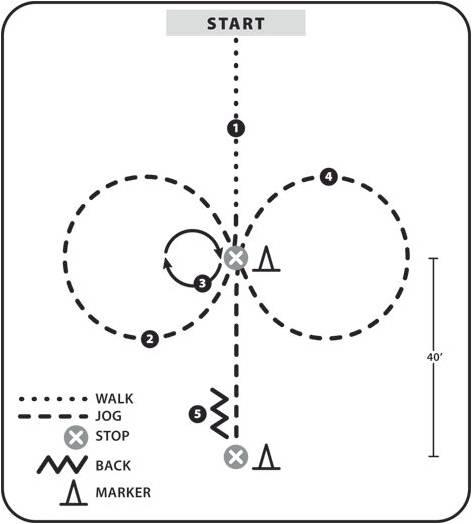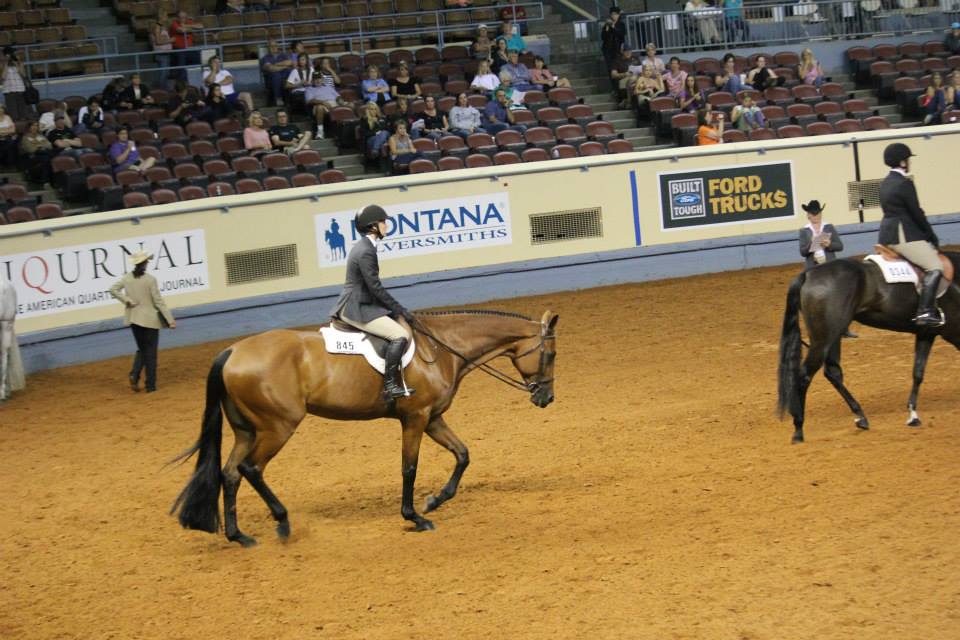
This event evaluates the ability of the hunter rider to perform various maneuvers on his or her horse which provides a base for natural progression to over-fence classes.
- Tests an amateur or youth’s ability to ride, not solely the performance of the horse.
- Contestants may work a predetermined pattern and/or perform rail work.
- Emphasizes the ability to sit correctly, hold the correct riding posture, and control the horse precisely with subtle cues.
Judging
Judging is based on performance of patterns, posting trot, two-point position, and hand gallop.
Patterns
Patterns may consist of maneuvers such as:
- Changing gaits
- Travel in a figure-8 pattern
- Backing
- Posting on correct diagonal
- Counter-cantering
Sample Pattern

The Posting Trot
- Correct diagonals
- Evaluated at the trot
- Rider must rise and fall (post) with the leg on the wall
Two-Point Position
<
Hand Gallop
- A three-beat, lengthened canter ridden in a two-point position
Scoring
This event is scored from 0 to 100, with 70 as an average performance.
- 90-100: Excellent equitation, including body position and use of aids. Completes pattern accurately, quickly, smoothly, and precisely; demonstrates a high level of professionalism
- 80-89: Very good rider who executes the pattern as well as correct equitation and use of aids. Excellent rider who commits a minor fault, or an excellent rider who commits a major fault.
- 70-79: Good pattern execution and average equitation but lacking the adequate style and professional presentation to merit elevating to the next scoring range. A very good rider who commits a minor fault.
- 60-69: Fair pattern that lacks quickness or precision. Rider has obvious position and/or appearance faults that prevent effective equitation. A good rider who commits one minor fault, or a very good rider who commits a major fault in the performance of the pattern.
- 50-59: One major fault or multiple minor faults in the performance. A rider who demonstrates a lack of riding ability and knowledge of correct body position.
- 40-49: Severe fault, two or more major faults, or multiple minor faults in the performance that demonstrate a lack of riding ability and knowledge of correct body position.
- 10-39: Exhibitor commits more than one severe fault or multiple major faults in the performance, exhibits poor riding skills but completes the class and avoids disqualification.
Beginning in 2019, new scoring recommendations will be implemented for showmanship, horsemanship, and equitation.
- The scoring range will be from 0 to infinity with an average score being 70
- Manuever scores will range from +3 to -3
- Scoring range: extremely poor -3, very poor -2, poor -1, average 0, good +1, very good +2, excellent +3
- Recommended for patterns to have 6 to 10 maneuvers to score
- Rider Form and Effectiveness (F&E) will be scored on a range of 0 to +5
- Penalty range: minor penalty -3, major penalty -5, severe penalty -10
Faults
Minor faults (-3)
-
- Break of gait at walk or trot up to two strides
- Over- or under-turn of 1/8 to 1/4
- Tick or hit of cone
- Obviously looking down to check leads or diagonals
Major faults (-5)
-
- Not performing the specific gait or not stopping when called for in the pattern within 10 feet of the designated location
- Missing a diagonal up to 2 strides in the pattern or on the rail
- Incorrect gait or break of gait (except when correcting an incorrect lead) at the canter
- Complete loss of contact between rider’s hand and the horse’s mouth
- Break of gait at walk or trot for more than two strides
- Loss of iron
- Head carried too low and/or clearly behind the vertical while the horse is in motion, showing the appearance of intimidation
Severe faults (-10)
-
- Loss of rein
- Missing a diagonal for more than two strides
- Use of either hand to instill fear or praise while on pattern or during rail work
- Holding saddle with either hand
- Spurring or use of crop in front of girth
- Blatant disobedience including kicking, pawing, bucking, and rearing
Disqualifications

- Failure to wear correct number in visible manner
- Willful abuse
- Illegal equipment
- Fall by horse or rider
- Illegal use of hands on reins
- Knocking over cone
- Excessive schooling or training
- Off pattern
- Knocking over or wrong side of cone
- Never perform designated gait, lead, or diagonal
- Over or under turning more than 1/4 turn
Examples of Equitation Runs
Example 1
<
Example 2
>
Saddle Seat Equitation Run
Resources
- AQHA Handbook
- Judging Equitation
- Updated Pattern Score Sheet



